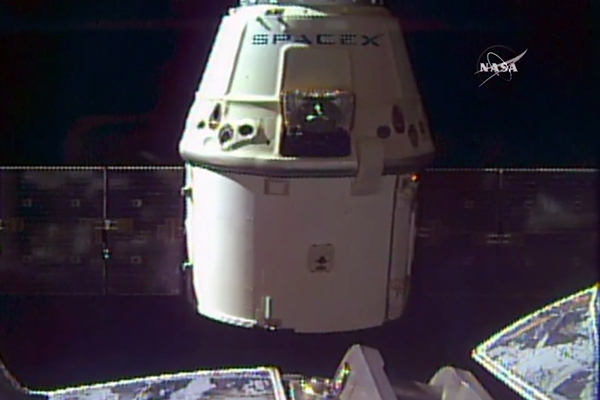
NASA Television image of SpaceX’s Dragon spacecraft departing the International Space Station at 6:10 am ET on 26 August 2016 (NASA)
26 August 2016. A SpaceX Dragon spacecraft returned today with samples from several biomedical research studies conducted by astronauts on the International Space Station. NASA says Dragon splashed down in the Pacific Ocean, southwest of Baja, California, today at 11:47 am ET.
The International Space Station provides a lab for astronauts to perform experiments that study effects of microgravity on biological processes. Among the 3,000 pounds of returned cargo were samples from a study of cardiomyocytes, or heart cells, derived from stem cells. The heart cell experiments studied effects of microgravity on growth of heart muscle tissue, as well as muscle contractions and changes in gene expression. The findings are expected to help understand health issues faced by astronauts who travel in space for extended periods of time.
Also returned are mice who experienced long periods in space to study effects of microgravity on molecular and physical changes in the musculoskeletal system. Space flight can cause loss of bone and muscle mass, particularly in the legs and spine, similar to muscle-wasting diseases. This experiment is sponsored by drug maker Eli Lilly and Co. and the Center for the Advancement of Science in Space.
Returned as well are a set of mice in an experiment sponsored by the Japan Aerospace Exploration Agency, which investigates changes in gene expression patterns in organs of male mice traveling in space for a month. The study is also looking into changes in the DNA from offspring of the mice. Still another study by the Japanese space agency, also returning samples, tests human microbial-metabolic cross-talk in microgravity. These experiments analyze the composition of microbes in the human digestive system and changes in metabolites related to astronauts’ immune functions.
The Dragon spacecraft is SpaceX’s cargo vehicle designed to launch 6,000 kilograms (13,228 pounds) and return 3,000 kilograms (6,614 pounds) from space. SpaceX has an agreement with NASA to upgrade the Dragon to fly human crew, which the company expects to take place in 2 to 3 years.
Read more:
- Report from Maker Faire: Plastic Recycling Made in Space
- Collaboration Explores Humanitarian Satellite Applications
- NASA to Test Hand-Held DNA Sequencer in Space Station
- Allied Minds Forming Space Signaling Company
- Astronauts to Eat Space-Grown Vegetables
* * *

 RSS - Posts
RSS - Posts
You must be logged in to post a comment.